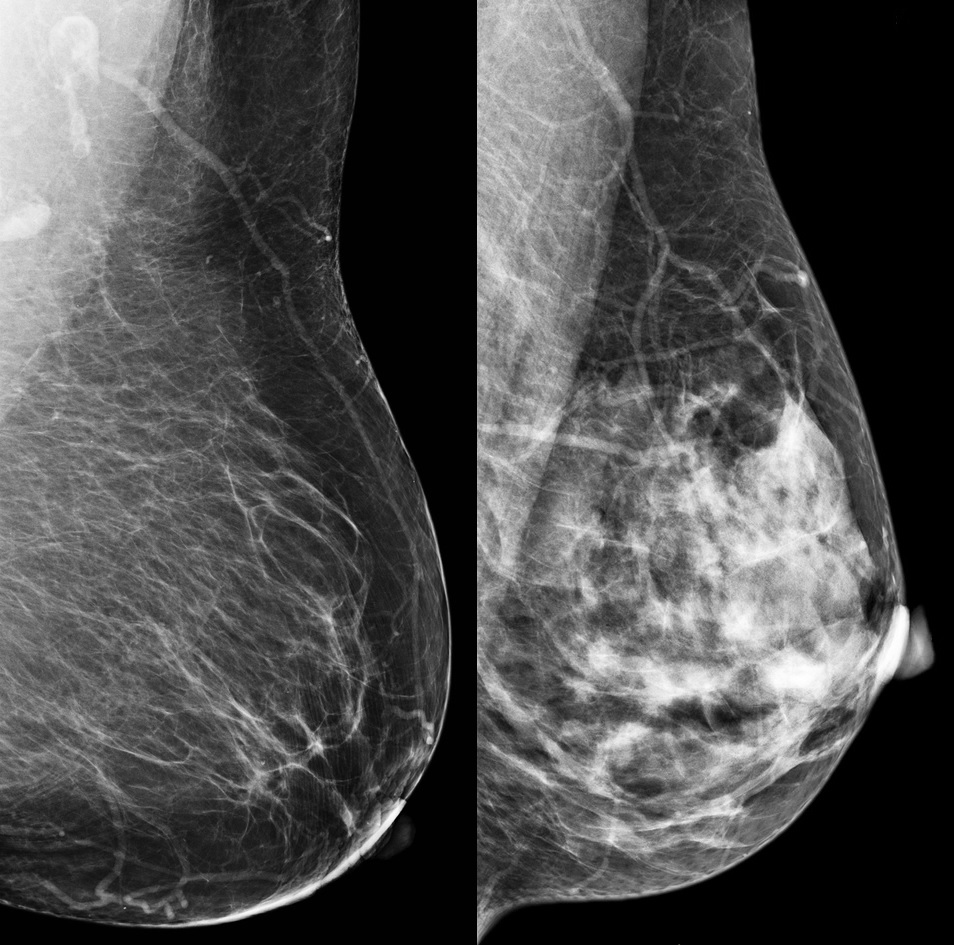What to Know About Dense Breasts and Breast Cancer Risk

A woman’s risk for breast cancer is due to a combination of several factors. One of the factors is having dense breasts. Women with dense breasts have a higher risk of getting breast cancer. About half of women who are 40 years old or older have dense breasts. Breast density refers to the amount of fibrous and glandular tissue in a woman’s breasts compared to the amount of fatty tissue in the breasts. On a mammogram, dense breast tissue and a possible tumor can both appear white, and it’s hard to tell the difference between the two. More imaging tests are sometimes recommended for women with dense breasts.
Knowing how breast density can affect your personal risk for breast cancer shows the importance of staying up-to-date on screenings. Talk with your doctor about which breast cancer screening tests are right for you and when you should have them.
What Does It Mean to Have Dense Breasts?
A mammogram shows how dense your breasts are. When you get the results of your mammogram, you may also be told if your breasts have low or high density. Women with dense breasts have a higher risk of getting breast cancer.
What Are the Parts of the Breast?


Click to see larger diagrams of the front view and side view of the breast, showing the parts of the breast.
A woman’s breast has three kinds of tissue—
- Fibrous tissue holds the breast tissue in place.
- Glandular tissue is the part of the breast that makes milk, called the lobes, and the tubes that carry milk to the nipple, called ducts. Together, fibrous and glandular tissue are called fibroglandular tissue.
- Fatty tissue fills the space between the fibrous tissue, lobes, and ducts. It gives the breasts their size and shape.
What Is Breast Density?
Breast density reflects the amount of fibrous and glandular tissue in a woman’s breasts compared with the amount of fatty tissue in the breasts, as seen on a mammogram.
On a mammography report, breast density is assigned to one of the following four categories—
- The breasts are almost entirely fatty (about 10% of women).
- A few areas of dense tissue are scattered through the breasts (about 40% of women).
- The breasts are evenly dense throughout (about 40% of women).
- The breasts are extremely dense (about 10% of women).
Women in the first two categories are said to have low-density, non-dense, or fatty breasts. Women in the second two categories are said to have high-density or dense breasts. About half of women who are 40 years old or older have dense breasts.
Why Is Breast Density Important?

The image on the left shows a mostly fatty breast, and the image on the right shows a dense breast.
Breast Cancer Risk
Women with dense breasts have a higher chance of getting breast cancer. The more dense your breasts are, the higher your risk. Scientists don’t know for sure why this is true.
Breast cancer patients who have dense breasts are not more likely to die from breast cancer than patients with non-dense (fatty) breasts.
Mammograms
Dense tissue can hide cancers. Fibrous and glandular tissue looks white on a mammogram. So does a possible tumor. Because it’s hard to tell the difference between a tumor and dense breast tissue on a mammogram, a small tumor may be missed.
Who Is More Likely to Have Dense Breasts?
The density of your breasts can change over time. Generally, you’re more likely to have dense breasts if you—
- Are younger.
- Are pregnant or breastfeeding.
- Are taking hormone replacement therapy.
- Have a lower body weight.
What Should I Do If I Have Dense Breasts?
Talk to your doctor about your personal risk of getting breast cancer. Dense breasts are just one of several risk factors for breast cancer. Your doctor will also think about other factors, like your age and family history of cancer.
Different tests may be able to find some cancers that are missed on a mammogram. But these tests are more likely to have a false positive result (the test is reported as abnormal, but you really don’t have cancer). False positive test results often lead to unnecessary tests, like a biopsy. Also, you may have to pay for these tests.
Your doctor may suggest one of these tests—
- Breast ultrasound. A machine that uses sound waves to make detailed pictures, called sonograms, of areas inside the breast.
- Magnetic resonance imaging (MRI). A kind of body scan that uses a magnet linked to a computer. The MRI scan makes detailed pictures of areas inside the breast.
Talk with your doctor about how often you should be screened for breast cancer and which tests your doctor recommends.
More Information
- Dense Breasts: Answers to Commonly Asked Questions (National Cancer Institute)
- Breast Density and Your Mammogram Report (American Cancer Society)
- Dense Breast Tissue: What It Means to Have Dense Breasts (Mayo Clinic)






















.png)











No hay comentarios:
Publicar un comentario